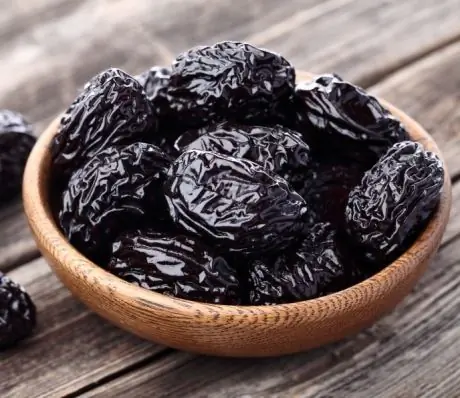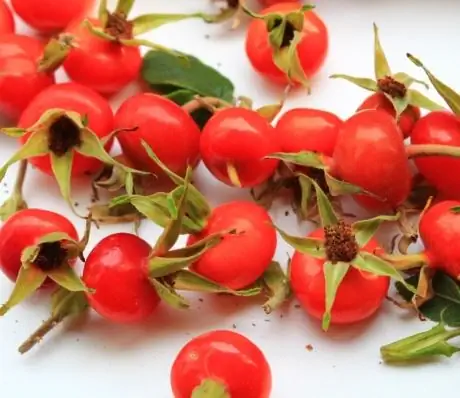- Author Rachel Wainwright [email protected].
- Public 2023-12-15 07:39.
- Last modified 2025-11-02 20:14.
Prunes
Pitted plums are called prunes. Usually, juicy ripe fruits of homemade plum of the Rosy family are chosen for drying.
The ratio of BJU in the product

Source: depositphotos.com How to burn 240 kcal?
| Walking | 60 minutes |
| Jogging | 27 minutes |
| Swimming | 20 minutes. |
| A bike | 34 minutes |
| Aerobics | 48 minutes |
| Household chores | 80 minutes |
Home plum is a short tree or large shrub that is widely cultivated in almost all European countries, as well as in the USA, China and Japan. Other varieties of plum are suitable for drying, the fruits of which are also dark in color and of a similar size.
Usually in countries where plums are grown, the production of prunes is also common. The most expensive and high-quality product is considered to be soft black prunes with a characteristic sweetish-sour taste, which are produced in North and South America, France and Moldova.
After harvesting, the plum fruits are blanched and, after cooling with running water, dried in steam dryers. The characteristic shine of prunes is given by glycerin, with which already dried fruits are processed.
The composition of prunes
Different varieties of plums differ in composition, but on average, prunes contain (in terms of 100 g):
- 56.9 g of poly- and monosaccharides;
- 32.4 g of water;
- 8.9 g dietary fiber;
- 3.5 g of organic acids;
- 0.1 g of unsaturated fatty acids;
- 2.3 g protein;
- 1.8 g of ash;
- 0.7 g fat;
- 0.6 g starch;
- Vitamins - C (from 3.3 mg), as well as PP, A, B1, B2, E, B9, B6, B5;
- Macronutrients - potassium (745-864 mg), as well as magnesium, calcium, phosphorus, chlorine and sodium;
- Trace elements - iron (from 2.47 mg), manganese, copper, zinc and selenium.
Calorie content of prunes
The calorie content of prunes is 264 kcal and this is similar to the rest of dried fruits, the calorie content of which ranges from 246 kcal (pear) to 292 kcal (cherry).
The high calorie content of prunes in comparison with fresh plums (43 kcal) is due to the shrinkage of fruits - from 5 kg of fresh plums, on average, no more than 1 kg of prunes is produced.
Useful properties of prunes
The beneficial properties of prunes are due to their rich vitamin and mineral composition. It has a diuretic, antibacterial and choleretic effect. Other medicinal properties of prunes include:
- Normalization of metabolism;
- Stimulation of gastric acid secretion;
- Increased appetite;
- Improving skin condition;
- Enhanced brain activity.
Also prunes are recognized as a good energy drink. It helps to quickly restore strength and performance after prolonged illness and stress, and improves overall health. Dried plums are often recommended for the treatment and prevention of the following diseases: gout, rheumatism, kidney and liver diseases.
The benefits of prunes
The benefits of prunes have been proven in numerous studies of this nutritious product. So, it can be considered as a kind of vitamin and mineral complex, while the dried plum contains practically no saturated fats. In this regard, nutritionists recommend eating prunes for weight loss.
Research in the United States has shown that prunes induce satiety faster than many flour products. At the same time, the level of glucose, as well as the hormone that utilizes it - insulin, in the blood after a "snack" with prunes is lower than after buns and cookies.
Also, the benefits of prunes are proven:
- To improve the functioning of the digestive system. Prunes are a laxative product and are recommended for constipation. This is facilitated by plant fiber and sorbitol, which are part of it. This property of prunes was confirmed by studies, the data of which were published in the USA in 2011, after which the doctors of this country can prescribe prunes as a laxative;
- To strengthen the immune system. Thanks to vitamin C and other useful components, prunes are an excellent antioxidant and helps to remove free radicals and other toxins from the body, which strengthens and restores immunity. Flavonoids and other phenolic antioxidants such as lutein also provide antioxidant protection and prevent aging;
- For the prevention of visual impairment, which is caused by vitamin A and beta-carotene, which are in significant quantities in dried plums;
- As a prevention of the development of heart disease. Potassium, fluoride and iron play a critical role in the formation of red blood cells, which improves blood counts and protects against the development of cardiovascular diseases such as hypertension, thrombophlebitis and atherosclerosis.
Application of prunes
Prunes can be eaten as a standalone product or added as an ingredient to various dishes. It is an excellent option to quickly satisfy hunger.
For hot drinks, it should be finely chopped and added along with the rest of the ingredients. Dried plum teas are especially useful during pregnancy, as they saturate the body with useful minerals and vitamins, as well as improve digestion.
Prunes are traditionally added to sweet pilaf, especially in the cuisine of Central Asian countries. It is also an ingredient in various appetizers, cakes and desserts, salads and meat dishes.
The use of prunes for weight loss
Many nutritionists advise eating prunes for weight loss. This is due to the rich vitamin composition with a relatively low calorie content and the ability to have a beneficial effect on the metabolic processes of the body.
So, prunes are included in the composition of fruit and berry and mixed diets, which, as a rule, give a quick and lasting result. In case you do not adhere to special diets, prunes also contribute to weight loss. To do this, it is recommended to observe the following rules:
- Eat 4-5 dried plums a day to reduce appetite and normalize blood sugar levels;
- There are prunes before meals, not after them, which reduces the volume of the main course;
- Use dried plums for “quick bites”. A mixture of prunes, dried apricots and nuts is also suitable for these purposes;
- Prepare porridge with prunes.

The harm of prunes
Due to its balanced composition, prunes can only bring harm if they are abused, which can cause digestive upset.
Also, with caution, you should include dried plums in your diet for obesity and diabetes mellitus, and nursing mothers are advised to first consult a pediatrician so as not to cause an upset stomach and colic in the child.
Prunes can also be harmful if the conditions of drying or storage have been violated. So, it is not recommended to eat prunes if it is bitter, has traces of mold or is brown, which indicates that it was subjected to repeated heat treatment, as a result of which it has lost most of its nutrients.
YouTube video related to the article:
Found a mistake in the text? Select it and press Ctrl + Enter.






